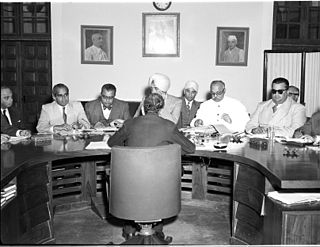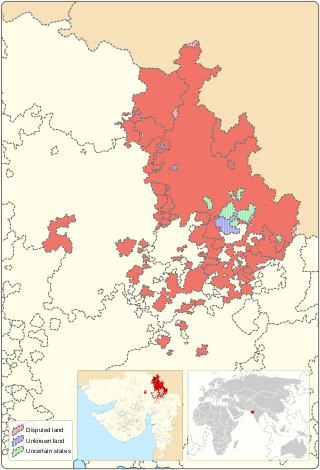The Residencies of British India were political offices, each managed by a Resident, who dealt with the relations between the British Government of India and one (or a territorial set) of princely states.
Contents

The Residencies of British India were political offices, each managed by a Resident, who dealt with the relations between the British Government of India and one (or a territorial set) of princely states.

The Residency system has its origins in the system of subsidiary alliances devised by the British after the Battle of Plassey in 1757, to secure Bengal from attack by deploying East India Company troops of the Bengal Army within friendly Native States. [1] Through this system, the Indian Princes of these Native States were assured of protection from internal or external aggression, through deployment of company troops. In return they had to pay for the maintenance of those troops and also accept a British Resident in their court. The Resident was a senior British official posted in the capital of these Princely States, technically a diplomat but also responsible for keeping the ruler to his alliance. [2] This was seen as a system of indirect rule that was carefully controlled by the British Resident. His role (and all were men) included advising in governance, intervening in succession disputes, and ensuring that the States did not maintain military forces other than for internal policing or else form diplomatic alliances with other States. [2] [3] The Residents attempted to modernize these Native States through promotion of European notions of progressive government. [2]
The first Native States to enter such subsidiary alliances included Arcot, Oudh and Hyderabad. [2] Before the Rebellion of 1857, the role of the British Resident in Delhi was more important than that of other Residents, because of the tension that existed between the declining Mughal Empire and the emerging power of the East India Company. [4] After the establishment of Crown rule of British India in 1858, the indigenous States ruled by the Indian princes retained their internal autonomy in terms of political and administrative control, while their external relations and defence became the responsibility of the Crown. An area over two-fifths of the Indian subcontinent was administered by native princes, [5] although nothing like such a high proportion in terms of population.

The continuation of Princely rule allowed the British to concentrate their resources on the more economically significant areas under their direct control and also obscured the effective loss of independence of these States in their external relations. [2]
The Resident was a permanent reminder of the subsidiary relationship between the indigenous ruler and the European power. [3] The physical manifestation of this was the Residency itself, which was a complex of buildings and land modified according to the aesthetic values of the suzerain power (Britain). The Residency was a symbol of power because of its size and position within the prince's capital. [6] In many instances, the local prince even paid for the erection of these Residencies, as a gesture of his support for and allegiance to the British. The Nawab of Oudh, one of the richest native princes, paid for and erected a splendid Residency in Lucknow as a part of a wider programme of civic improvements. [5]
North India
Part of Central India Agency
Part of Rajputana Agency
Other Residencies
Former Residencies

India is a federal union comprising 28 states and 8 union territories, for a total of 36 entities. The states and union territories are further subdivided into 806 districts and smaller administrative divisions.

The Indian Rebellion of 1857 was a major uprising in India in 1857–58 against the rule of the British East India Company, which functioned as a sovereign power on behalf of the British Crown. The rebellion began on 10 May 1857 in the form of a mutiny of sepoys of the company's army in the garrison town of Meerut, 40 miles (64 km) northeast of Delhi. It then erupted into other mutinies and civilian rebellions chiefly in the upper Gangetic plain and central India, though incidents of revolt also occurred farther north and east. The rebellion posed a military threat to British power in that region, and was contained only with the rebels' defeat in Gwalior on 20 June 1858. On 1 November 1858, the British granted amnesty to all rebels not involved in murder, though they did not declare the hostilities to have formally ended until 8 July 1859.

The Rajputana Agency was a political office of the British Indian Empire dealing with a collection of native states in Rajputana, under the political charge of an Agent reporting directly to the Governor-General of India and residing at Mount Abu in the Aravalli Range. The total area of the states falling within the Rajputana Agency was 127,541 square miles (330,330 km2), with eighteen states and two estates or chiefships.

A princely state was a nominally sovereign entity of the British Indian Empire that was not directly governed by the British, but rather by an Indian ruler under a form of indirect rule, subject to a subsidiary alliance and the suzerainty or paramountcy of the British crown.

Rajpramukh was an administrative title in India which existed from India's independence in 1947 until 1956. Rajpramukhs were the appointed governors of certain Indian provinces and states.

The Bombay Presidency or Bombay Province, also called Bombay and Sind (1843–1936), was an administrative subdivision (province) of India, with its capital in the city that came up over the seven islands of Bombay. The first mainland territory was acquired in the Konkan region with the Treaty of Bassein. Poona was the summer capital.

Mahi Kantha was a political agency or collection of princely states in British India, within the Gujarat Division of Bombay Presidency. In 1933, the states of the Mahi Kantha Agency, except for Danta, were included in the Western India States Agency. The total area of the agency was 8,094 km2 (3,125 sq mi); the population in 1901 was 361,545.

Before it gained independence in 1947, India was divided into two sets of territories, one under direct British rule, and the other consisting of princely states under the suzerainty of the British Crown, with control over their internal affairs remaining to varying degrees in the hands of their hereditary rulers. The latter included 562 princely states which had different types of revenue-sharing arrangements with the British, often depending on their size, population and local conditions. In addition, there were several colonial enclaves controlled by France and Portugal. After independence, the political integration of these territories into an Indian Union was a declared objective of the Indian National Congress, and the Government of India pursued this over the next decade.

A salute state was a princely state under the British Raj that had been granted a gun salute by the British Crown ; i.e., the protocolary privilege for its ruler to be greeted—originally by Royal Navy ships, later also on land—with a number of cannon shots, in graduations of two salutes from three to 21, as recognition of the state's relative status. The gun-salute system of recognition was first instituted during the time of the East India Company in the late 18th century and was continued under direct Crown rule from 1858.

The provinces of India, earlier presidencies of British India and still earlier, presidency towns, were the administrative divisions of British governance on the Indian subcontinent. Collectively, they have been called British India. In one form or another, they existed between 1612 and 1947, conventionally divided into three historical periods:

Gwalior Residency was a political office in the British Indian Empire, which existed from 1782 until the British withdrawal from India in 1947.

The Gwalior State was a state within the Maratha Confederacy located in Central India. It was ruled by the House of Scindia, a Hindu Maratha dynasty. Following the dissolution of the Confederacy, it became part of the Central India Agency of the Indian Empire under British protection.

A subsidiary alliance, in South Asian history, was a tributary alliance between an Indian state and a European East India Company.

An agency of British India was an internally autonomous or semi-autonomous unit of British India whose external affairs were governed by an agent designated by the Viceroy of India.

The Baroda Residency was one of the residencies of British India, managing the relations of the British with Baroda State between 1806 and the 1930s.
William Hutt Curzon Wyllie was a British Indian army officer, and later an official of the British Indian Government. Over a career spanning three decades, Curzon Wyllie rose to be a Lieutenant Colonel in the British Indian Army and occupied a number of administrative and diplomatic posts. He was the British resident to Nepal and the Princely state of Rajputana, and later, the political aide-de-camp to the Secretary of State for India, Lord George Hamilton. Curzon Wyllie was assassinated on 1 July 1909 in London by the Indian revolutionary Madan Lal Dhingra, who was a member of India House in London.

Baroda State was a kingdom within the Maratha Confederacy and later a princely state in present-day Gujarat. It was ruled by the Gaekwad dynasty from its formation in 1721 until its accession to the newly formed Dominion of India. With the city of Baroda (Vadodara) as its capital, its relations with the British Raj authorities were managed by the Baroda Residency. The revenue of the state in 1901 was Rs. 13,661,000. Baroda merged into the Dominion of India on 1 May 1949, before which an interim government was formed in the state.

The Oudh State was a Mughal subah, then an independent kingdom, and lastly a princely state in the Awadh region of North India until its annexation by the British in 1856. The name Oudh, now obsolete, was once the anglicized name of the state, also written historically as Oudhe.

The divisions of British India were the administrative divisions of the Government of the British Raj or the Indian Empire.